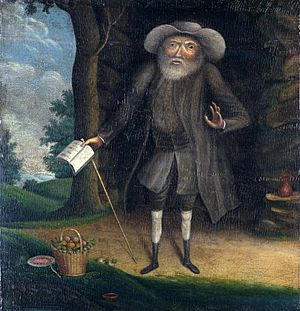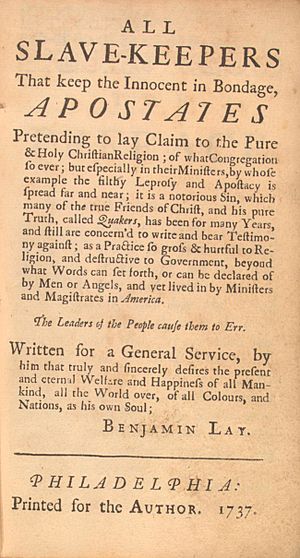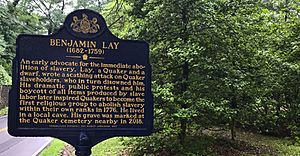Benjamin Lay facts for kids
Quick facts for kids
Benjamin Lay
|
|
|---|---|

Benjamin Lay painted by William Williams in 1750
|
|
| Born | January 26, 1682 Copford, England |
| Died | February 8, 1759 (aged 77) Abington, Pennsylvania, U.S. |
| Occupation | Shepherd, glove-maker, sailor, merchant, writer |
| Spouse |
Sarah Smith
(m. 1718; died 1735) |
|
Pennsylvania Historical Marker
|
|
| Official name | Benjamin Lay (1682–1759) |
| Designated | September 22, 2018 |
Benjamin Lay (born January 26, 1682 – died February 8, 1759) was an Anglo-American Quaker who worked to help others. He was a strong voice against slavery. He is famous for his dramatic protests against slavery. Benjamin Lay was also a writer, farmer, and vegetarian. He cared deeply about how animals were treated.
Lay was born in England into a farming family. He first worked as a shepherd and made gloves. After becoming a Quaker, he became a sailor. In 1718, he moved to Barbados. There, he saw how badly enslaved African people were treated. This experience made him a lifelong opponent of slavery. Lay later moved to Philadelphia. His strong anti-slavery views made him unpopular with some fellow Quakers. He wrote many articles and one book against slavery. His book, All Slave-Keepers That Keep the Innocent in Bondage, Apostates, was one of the first books in North America to speak out against slavery.
Contents
Benjamin Lay's Early Life
Benjamin Lay was born in 1682. His parents were Quakers and lived in Copford, near Colchester, England. He worked on farms and as a shepherd. He also learned to make gloves. At age 21, Lay ran away to London and became a sailor. He later returned to England and married Sarah Smith around 1718.
In 1718, Lay moved to Barbados to work as a merchant. But he soon became very unpopular. This was because he strongly opposed slavery. Most people in Barbados made money from slavery. In 1731, Lay moved to the British Pennsylvania colony. He first settled in Philadelphia and later in Abington. In Abington, he was one of the first and most passionate people to speak out against slavery. At this time, Quakers had not yet officially organized against slavery.
Lay's Unique Lifestyle
Benjamin Lay was a short man, just over four feet tall. He often called himself "Little Benjamin." He had a curved back and long arms. He was a vegetarian, meaning he only ate fruits, vegetables, and honey. He drank only milk and water. Lay believed that humans were not better than animals. He even made his own clothes. He did this to avoid buying anything made by enslaved people. He also refused to use anything that caused harm to animals.
After his wife died, Lay lived a very simple life. He wanted to avoid a society he saw as unfair and cruel. He lived in a cave in the Pennsylvania countryside. He kept goats and grew fruit trees. He also grew flax to make his own clothes. Inside his cave, he had many books. These books covered topics like religion, history, and poetry.
Lay was known for his kindness and generosity. He wrote many articles. Most of these articles strongly criticized social problems of his time. He spoke out against slavery, the death penalty, and the prison system. He also criticized wealthy Quakers in Pennsylvania.
Fighting Against Slavery
Benjamin Lay first started fighting against slavery in Barbados. He saw an enslaved man die, which deeply affected him. His strong feelings against slavery came from his Quaker beliefs. Lay used many dramatic ways to protest slavery.
Once, in winter, he stood outside a Quaker meeting without a coat. One of his feet was bare in the snow. When people worried about him, he said that enslaved people were forced to work outside in winter dressed just like him.
At a Quaker meeting in Burlington, New Jersey, in 1738, he performed a very famous protest. He dressed like a soldier. After speaking against slavery, he used a dramatic act to show his strong feelings. He held a Bible that had a hidden bladder filled with red berry juice. He then used a small tool to pierce the bladder, making the red juice spray out. This was to show the "blood" of enslaved people.
Friendship with Benjamin Franklin
Benjamin Franklin helped Benjamin Lay by printing his book, All Slave Keepers That keep the Innocent in Bondage, Apostates. Franklin sold the book for a small price. Franklin often visited Lay in his later years, after Lay had become a hermit. At one point, Franklin owned enslaved people. Lay challenged him, asking: With What Right? In 1757, Franklin decided that his enslaved people, Peter and Jemima, would be freed after his death.
Franklin's wife, Deborah Read, asked William Williams to paint a picture of Benjamin Lay. This painting became well-known. It was later found and is now in the National Portrait Gallery in Washington, DC.
Lay's Lasting Impact
Benjamin Lay died in Abington, Pennsylvania, in 1759. His work continued to inspire the movement to end slavery for many years. In the 1800s, many Quaker abolitionists kept pictures of Lay in their homes. Benjamin Lay was buried in the Abington Friends Meeting's burial ground. His exact grave location is not known, but it is near the meeting house and Abington Friends School in Jenkintown, Pennsylvania.
In 2018, the Pennsylvania Historical and Museum Commission placed a historical marker in Abington to remember Lay. Also in 2018, Abington Friends Meeting placed a grave marker for Benjamin and Sarah Lay in their graveyard.
Benjamin Lay had been strongly disagreed with by some Quaker groups for his strong campaigning. But in 2018, one of these groups, Southern East Anglia Area Meeting in Britain, officially recognized his importance. Other Quaker groups in the USA and Britain had also done this.
A room at Friends House in London, UK, is named the Benjamin Lay room in his honor.
See also
- Thomas Tryon, one of Benjamin Lay's influences; in the Williams painting, Lay is holding a copy of one of Tryon's works
- List of abolitionist forerunners



